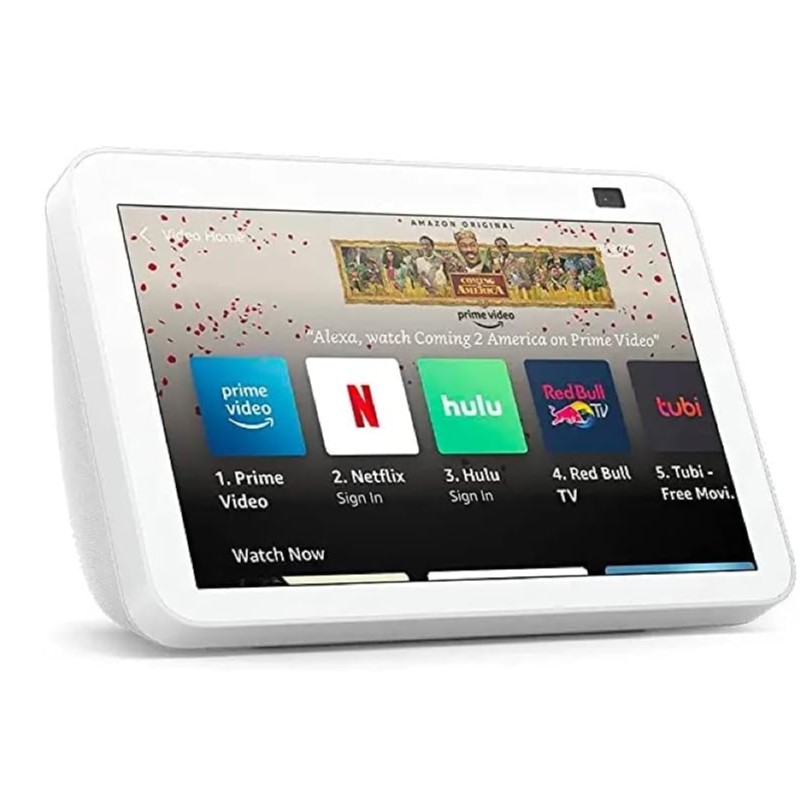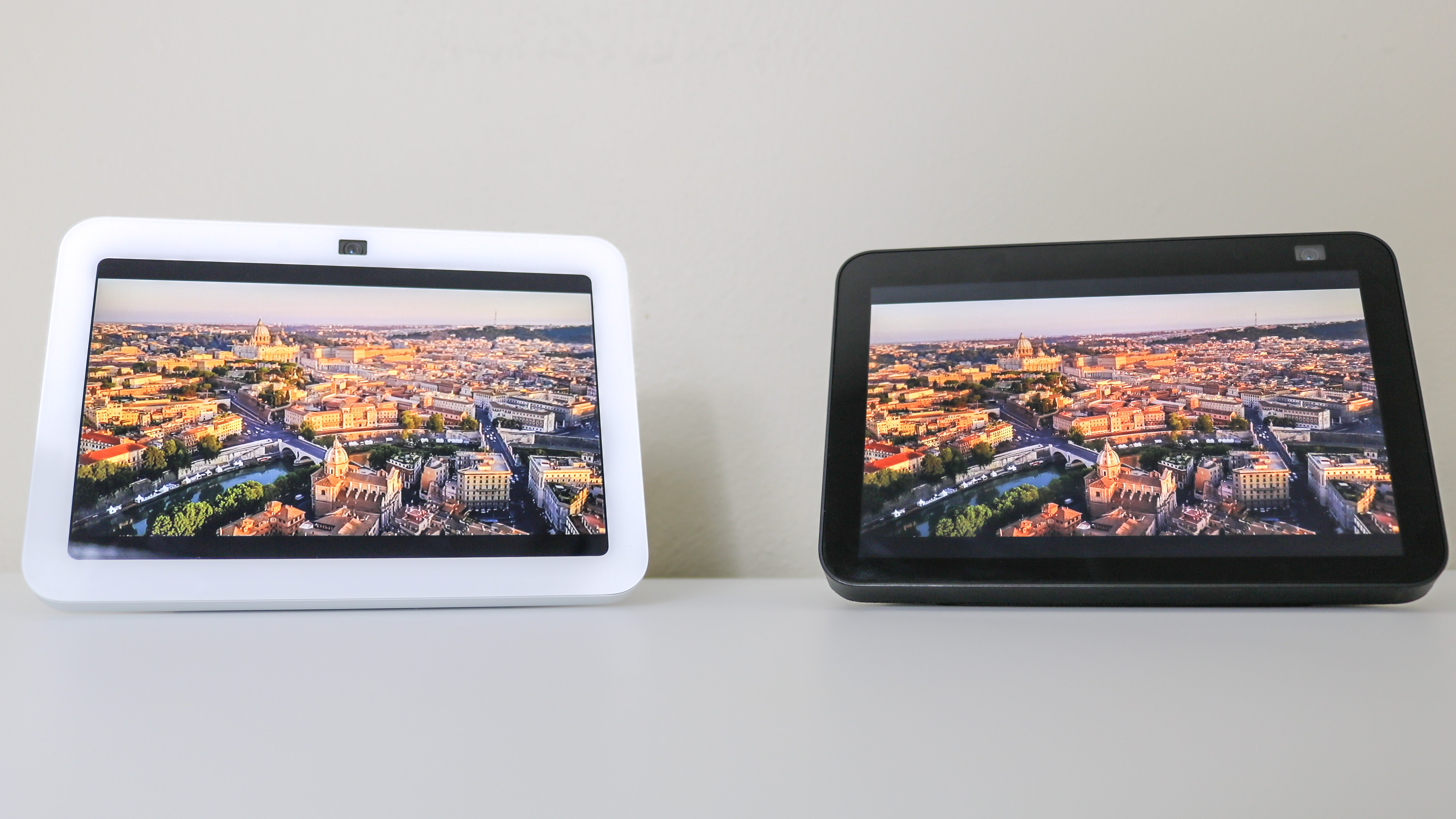Echo Show 8 (3rd Gen) vs Echo Show 8 (2nd Gen) — which smart display should you buy?
How to choose the best Alexa-enabled 8-inch smart display for you

The Echo Show 8 (3rd Gen) sports a new industrial design, an edge-to-edge glass display, and improved processor and finally, a centered camera. It also responds to smart home requests faster and even works as a smart home hub thanks to Zigbee, Thread and Matter support.
Pros
- Sleek new design
- Built-in smart home hub
- Centered camera
Cons
- Lacks eero built-in

The Echo Show (2nd Gen) offers some improvements over its predecessor including a 13MP camera with auto-framing for keeping you right in the middle of video calls. It has a more responsive display and also comes with Amazon Sidewalk to help your outdoor smart devices connected.
Pros
- Frequently discounted
- Good sound for the size
- Bright and colorful screen
Cons
- No Zigbee built-in
If you’re in the kitchen or just getting out of bed, one of the best smart displays can really come in handy when you want to have glanceable information about the weather, your schedule, recipes and more right there in front of you.
Although Google also makes smart displays, Amazon has the widest selection of them available in a range of different screen sizes and form factors. If the Echo Show 5 is too small for your needs and you don’t have enough space for the larger Echo Show 10 or Echo Show 15, the Echo Show 8 is the perfect middle ground.
First released in 2019, the Echo Show 8 has an 8-inch HD screen, stereo speakers and even a 13MP camera for video calls and checking in on your home when you’re out and about. Now though, Amazon has released an upgraded version of the Echo Show 8 with an all-new industrial design, an improved processor and additional smart home features.
Whether you’re looking to pick up your first Alexa-powered smart display this Black Friday or you’re considering upgrading to the latest version of the Echo Show 8, this is everything you need to know about the differences between the Echo Show 8 (2nd Gen) and the Echo Show 8 (3rd Gen).
Echo Show 8 (3rd Gen) vs Echo Show 8 (2nd Gen): Pricing
The new Echo Show 8 (3rd Gen) is available for $150 on Amazon in either Charcoal or Glacier White. It’s slightly more expensive than the Echo Show 8 (2nd Gen) which was priced at $130 back when it was released in 2021. If you don’t need all of the features and upgrades in the latest version, the Echo Show 8 (2nd Gen) is on sale for $60 at Amazon right now which is over 50% off its original price.
Echo Show 8 (3rd Gen) vs Echo Show 8 (2nd Gen): Specs
| Header Cell - Column 0 | Echo Show 8 (3rd Gen) | Echo Show 8 (2nd Gen) |
|---|---|---|
| Price | $149.99 | $129.99 |
| Year released | 2023 | 2021 |
| Size | 7.9 x 5.5 x 4.2 inches | 7.9 x 5.4 x 3.9 inches |
| Display | 8 inches/1280 x 800 | 8 inches/1280 x 800 |
| Audio | Dual two-inch tweeters, Amazon spatial audio and room adaption tech | Dual one-inch tweeters |
| Camera | 13MP (centered) | 13MP (right side) |
| Wireless | 802.11a/b/g/n/ac Wi-Fi, Bluetooth, Sidewalk, Zigbee, Matter, Thread | 802.11a/b/g/n/ac Wi-Fi, Bluetooth, Sidewalk |
Echo Show 8 (3rd Gen) vs Echo Show 8 (2nd Gen): Design

Although the 3rd and 2nd generation Echo Show 8 look somewhat similar from the front, it’s when you turn them around that you really notice how Amazon has tweaked the design of its 8-inch smart display. The large hump at the back of the Echo Show 8 (2nd Gen) has been trimmed down and this allows the Echo Show 8 (3rd Gen)’s edge-to-edge glass display to stand out more prominently.
At the same time, Amazon has removed the micro USB port next to where the power plug goes in at the back of the latest Echo Show 8. If you’re wondering what this port was for, it was included for micro USB to Ethernet adapters for those without one of the best Wi-Fi routers. Although small, this change certainly helps make the Echo Show 8 (3rd Gen) look a lot more modern.
Get instant access to breaking news, the hottest reviews, great deals and helpful tips.

One of the biggest changes with the new Echo Show 8 (3rd Gen) is where the front-facing camera is located. As a result of this, Amazon has changed where the buttons are placed on the top of the device. To the left of the camera’s privacy shutter on the Echo Show 8 (3rd Gen), there’s a mute switch while its volume up and volume down buttons are on the right. Besides moving these buttons around, their shape has also been changed and while they were smaller and circular on the Echo Show 8 (2nd Gen), they’re now wider and pill shaped on the Echo Show (3rd Gen) which makes them easier to find and press.
The Echo Show 8 (3rd Gen) is definitely a sleeker-looking smart display thanks to its improved design but the Echo Show 8 (2nd Gen) still looks quite good in your kitchen or bedroom.
Echo Show 8 (3rd Gen) vs Echo Show 8 (2nd Gen): Display and audio

As their name implies, both the 2nd generation and 3rd generation Echo Show 8 have an 8-inch, HD display with a resolution of 1280 x 800. I played Book Club: The Next Chapter from Amazon Prime Video on both devices and while picture quality is similar, scenes from the film on the Echo Show 8 (3rd Gen) appear slightly brighter.
Although you can watch content from the best streaming services on both devices, the Echo Show 8 (3rd Gen) now lets you watch over 420 live and ad-supported video channels for free with Fire TV Channels. From news to sports to cooking programs, you always have something to watch and all you have to do to get started is say “Alexa, watch TV.”
On the audio front, the Echo Show 8 (3rd Gen) has seen some major upgrades over its predecessor. While the Echo Show 8 (2nd Gen) comes equipped with dual one-inch tweeters, this latest model has dual two-inch tweeters which help improve clarity and bass. That’s not all though, as the latest Echo Show 8 also features spatial audio and Amazon’s room adaption technology automatically analyzes the acoustics of the room the device is placed in.
If better audio and picture quality are what you’re after, then the Echo Show 8 (3rd Gen) is the obvious choice. However, the Echo Show 8 (2nd Gen) still holds its own when compared to Google’s Nest Hub (2nd Gen).
Echo Show 8 (3rd Gen) vs Echo Show 8 (2nd Gen): Cameras

While we may not be making as many video calls as we used to, dropping in on friends, family and loved ones is one of the best features built-in to Amazon’s smart displays. Drop in lets you instantly start a conversation with someone else inside your home using another Echo Show or with any of your contacts. However, if you don’t wish to be disturbed, you can use the built-in privacy shutter on either the 2nd or 3rd generation Echo Show 8 or disable the feature altogether.
With the latest generation of the Echo Show 8, Amazon has done something its users have been requesting for quite some time: it moved the camera from the right side to the center. While both the 2nd and 3rd generation Echo Show 8 have auto-framing to keep you in the center of the frame even as you move about the room, having the camera dead center makes video calls feel more natural.
In addition to video calling, you can also use the camera on either Echo Show 8 to check in on your house when you’re away just like you would with one of the best home security cameras. This feature works equally well on both devices since they both have a 13MP camera but on the Echo Show 8 (3rd Gen), it’s easier to get a centered view of the room your device is currently in due to the placement of its camera.
If you just want to be able to check in on your home when you’re away, the Echo Show 8 (2nd Gen) might be all you need. However, if video calling is one of the reasons you’re interested in Amazon’s 8-inch smart display, then the Echo Show 8 (3rd Gen) is the better choice.
Echo Show 8 (3rd Gen) vs Echo Show 8 (2nd Gen): Smart home and connectivity

Both the 2nd and 3rd generation Echo Show 8 make it easy to control the best smart home devices. With either smart display, you can use your voice to control your smart lights, smart plugs and other connected devices but if it’s late and you don’t want to disturb anyone, you can also tap on their displays to do so as well.
One of the biggest upgrades with the Echo Show 8 (3rd Gen) though is that Amazon has added a built-in smart home hub to the device. Unlike its predecessor which ships with Wi-Fi Bluetooth and Amazon Sidewalk, it now also includes Zigbee, Thread and Matter support. While Zigbee and Thread have been around for longer, Matter is a much newer protocol that’s designed to make setting up and adding new devices to your smart home faster as well as easier.
It’s also worth mentioning that the Echo Show 8 (3rd Gen) runs a new spoken language model which enables Alexa to process common smart home requests locally 40% faster. Even though Alexa is already faster than Google Assistant when it comes to controlling lights, this should help speed up the process of carrying out the requests you make to your smart display.
Some of the best Alexa speakers like the Echo Dot (4th Gen) can also serve as a smart home hub as they ship with Zigbee support, but only the latest Echo Show 8 comes with Thread and Matter too. If you’re after one device to manage your entire smart home, the Echo Show 8 (3rd Gen) is the smart display to get. However, if you already have a smart home hub, the Echo Show 8 (2nd Gen) is more than capable of giving you full control over all of your smart home devices.
Echo Show 8 (3rd Gen) vs Echo Show 8 (2nd Gen): Which should you get?

The Echo Show 8 (3rd Gen) and Echo Show 8 (2nd Gen) share a lot of similarities but if you’re buying one of Amazon’s 8-inch smart displays for the first time, it could be worth paying more for the latest model if you need all of the new features and upgrades it includes. However, if you’re on a tight budget and don’t plan on using the device for video calls or controlling a lot of smart home devices, it might make sense to pick up the Echo Show 8 (2nd Gen) at a steep discount now that a newer model is available.
It’s up to you to decide which version of the Echo Show 8 will work best for your needs and household but you can’t really go wrong with either one. Still though, the Echo Show 8 (3rd Gen) offers a number of improvements that really go a long way to making it one of the best smart displays you can get today.
More from Tom's Guide
- This one feature makes the Amazon Echo Show 15 the best TV for sports
- Google Pixel Tablet vs. Google Nest Hub Max: Which is best for you?
- I added a smart display under my monitor and it’s changed the way I work

Anthony Spadafora is the managing editor for security and home office furniture at Tom’s Guide where he covers everything from data breaches to password managers and the best way to cover your whole home or business with Wi-Fi. He also reviews standing desks, office chairs and other home office accessories with a penchant for building desk setups. Before joining the team, Anthony wrote for ITProPortal while living in Korea and later for TechRadar Pro after moving back to the US. Based in Houston, Texas, when he’s not writing Anthony can be found tinkering with PCs and game consoles, managing cables and upgrading his smart home.
